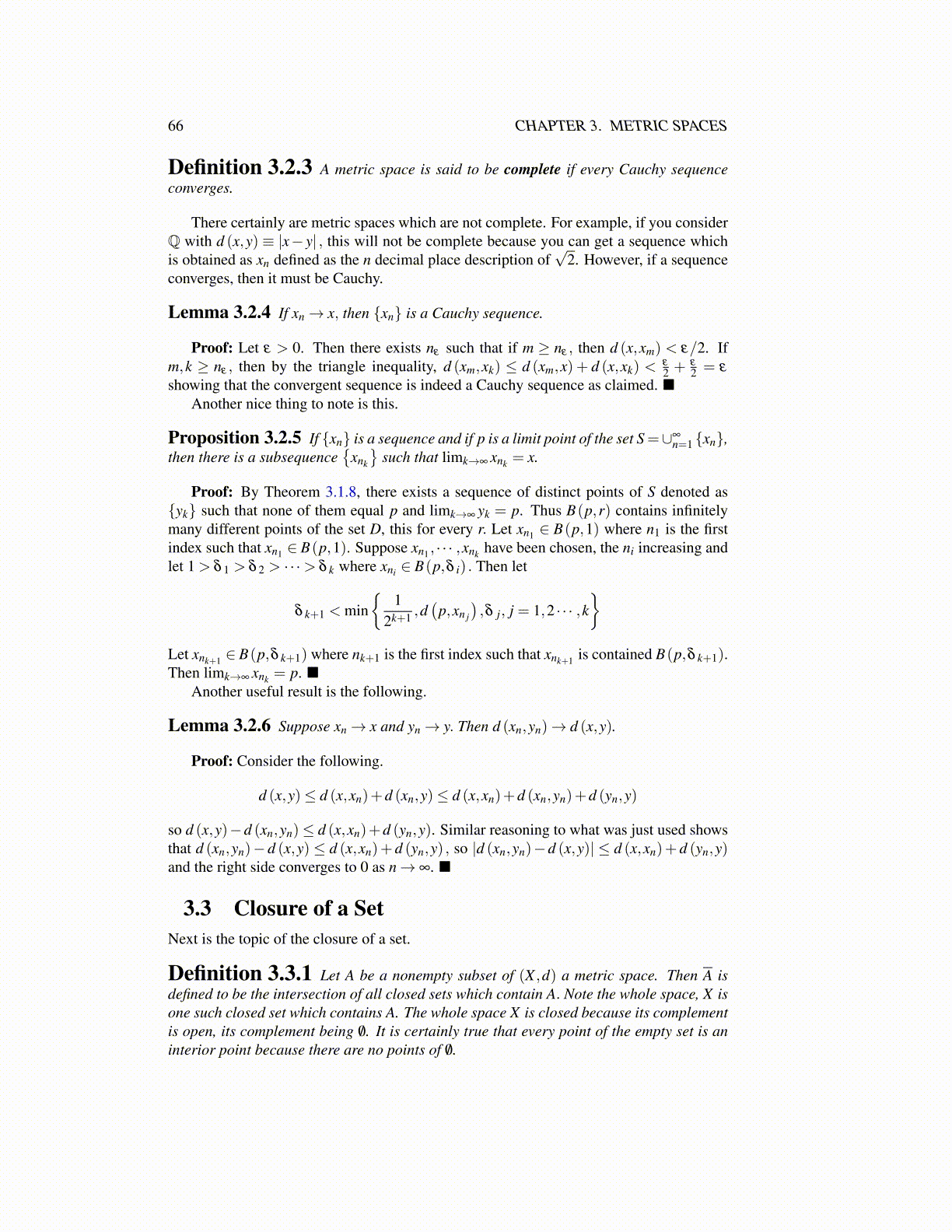
66 CHAPTER 3. METRIC SPACES
Definition 3.2.3 A metric space is said to be complete if every Cauchy sequenceconverges.
There certainly are metric spaces which are not complete. For example, if you considerQ with d (x,y) ≡ |x− y| , this will not be complete because you can get a sequence whichis obtained as xn defined as the n decimal place description of
√2. However, if a sequence
converges, then it must be Cauchy.
Lemma 3.2.4 If xn→ x, then {xn} is a Cauchy sequence.
Proof: Let ε > 0. Then there exists nε such that if m ≥ nε , then d (x,xm) < ε/2. Ifm,k ≥ nε , then by the triangle inequality, d (xm,xk) ≤ d (xm,x) + d (x,xk) <
ε
2 + ε
2 = ε
showing that the convergent sequence is indeed a Cauchy sequence as claimed. ■Another nice thing to note is this.
Proposition 3.2.5 If {xn} is a sequence and if p is a limit point of the set S=∪∞n=1 {xn},
then there is a subsequence{
xnk
}such that limk→∞ xnk = x.
Proof: By Theorem 3.1.8, there exists a sequence of distinct points of S denoted as{yk} such that none of them equal p and limk→∞ yk = p. Thus B(p,r) contains infinitelymany different points of the set D, this for every r. Let xn1 ∈ B(p,1) where n1 is the firstindex such that xn1 ∈ B(p,1). Suppose xn1 , · · · ,xnk have been chosen, the ni increasing andlet 1 > δ 1 > δ 2 > · · ·> δ k where xni ∈ B(p,δ i) . Then let
δ k+1 < min{
12k+1 ,d
(p,xn j
),δ j, j = 1,2 · · · ,k
}Let xnk+1 ∈ B(p,δ k+1) where nk+1 is the first index such that xnk+1 is contained B(p,δ k+1).Then limk→∞ xnk = p. ■
Another useful result is the following.
Lemma 3.2.6 Suppose xn→ x and yn→ y. Then d (xn,yn)→ d (x,y).
Proof: Consider the following.
d (x,y)≤ d (x,xn)+d (xn,y)≤ d (x,xn)+d (xn,yn)+d (yn,y)
so d (x,y)−d (xn,yn)≤ d (x,xn)+d (yn,y). Similar reasoning to what was just used showsthat d (xn,yn)− d (x,y) ≤ d (x,xn)+ d (yn,y) , so |d (xn,yn)−d (x,y)| ≤ d (x,xn)+ d (yn,y)and the right side converges to 0 as n→ ∞. ■
3.3 Closure of a SetNext is the topic of the closure of a set.
Definition 3.3.1 Let A be a nonempty subset of (X ,d) a metric space. Then A isdefined to be the intersection of all closed sets which contain A. Note the whole space, X isone such closed set which contains A. The whole space X is closed because its complementis open, its complement being /0. It is certainly true that every point of the empty set is aninterior point because there are no points of /0.